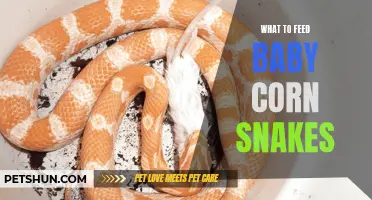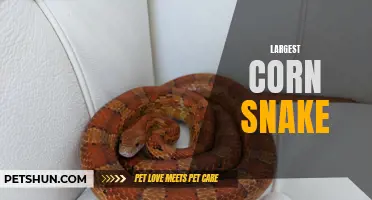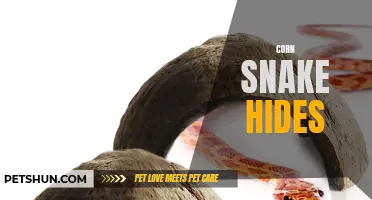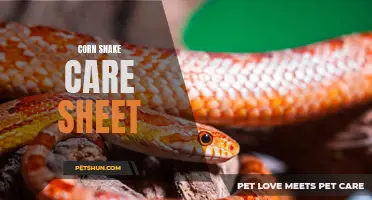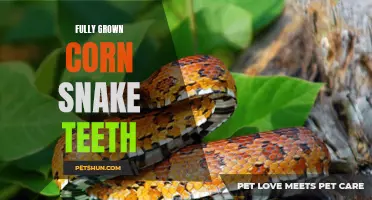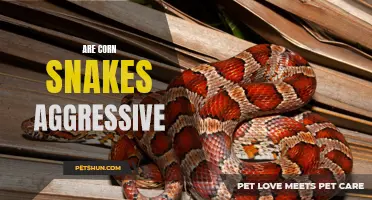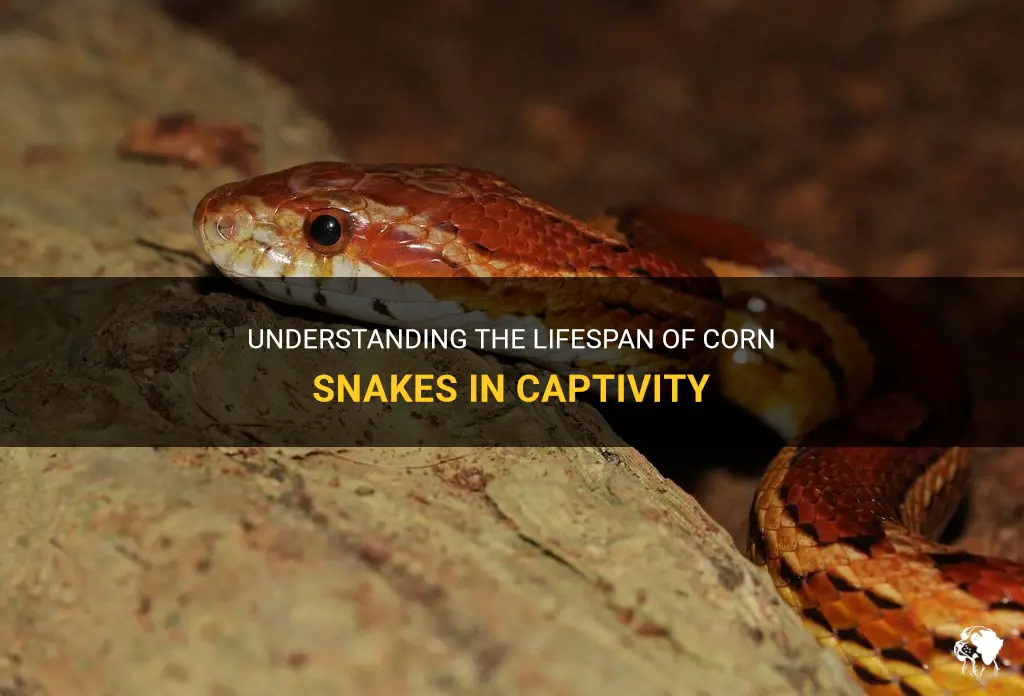
Did you know that the corn snake, scientifically known as Pantherophis guttata, can live up to 20 years in captivity? These docile and low-maintenance reptiles have captured the hearts of snake enthusiasts worldwide. Despite their relatively long lifespan, proper care and a suitable environment are essential to ensure their longevity. From their striking patterns to their fascinating behavior, corn snakes have become a favored choice among snake connoisseurs. Join us on a journey to discover the secrets of their captivating lifespans in human care.
What You'll Learn
- How long do corn snakes typically live in captivity?
- What factors can affect the lifespan of a corn snake in captivity?
- Is there a difference in lifespan between wild-caught and captive-bred corn snakes?
- What are the key elements of proper care and husbandry that can impact the lifespan of a corn snake in captivity?
- Are there any common health issues or diseases that can shorten the lifespan of a corn snake in captivity?

How long do corn snakes typically live in captivity?
Corn snakes are popular pets because of their docile nature and attractive patterns. If you are considering getting a corn snake as a pet, it is important to understand how long they typically live in captivity. This information will help you make an informed decision and ensure that you are able to provide the proper care for your new pet.
On average, corn snakes live for about 15 to 20 years in captivity. However, with proper care, some corn snakes have been known to live into their late 20s or even early 30s. The lifespan of a corn snake can be influenced by factors such as genetics, diet, and overall health.
In terms of genetics, some corn snakes may have a predisposition to certain health issues or a shorter lifespan. It is important to choose a reputable breeder and select a snake that comes from healthy stock. This can help increase the chances of your corn snake living a long and healthy life.
Diet is another important factor that can impact the lifespan of a corn snake. In captivity, corn snakes typically eat a diet of mice and rats. It is important to provide a varied and balanced diet to ensure that your snake is receiving all of the necessary nutrients. Overfeeding or feeding an improper diet can lead to obesity and other health issues that can shorten the lifespan of your pet.
Proper care and husbandry are essential for the health and longevity of your corn snake. This includes providing a suitable habitat with the correct temperature and humidity levels, as well as regular cleaning and maintenance. It is also important to handle your snake regularly and provide enrichment to keep them mentally and physically stimulated.
Regular veterinary check-ups are important for identifying and addressing any potential health issues early on. It is recommended to find a reptile veterinarian who has experience with corn snakes or other reptiles. They can provide guidance on proper care, as well as detect and treat any health problems that may arise.
In summary, corn snakes typically live for about 15 to 20 years in captivity, but with proper care and attention, they can live even longer. Genetics, diet, and overall health are all important factors that can influence the lifespan of a corn snake. By providing a suitable habitat, a balanced diet, regular veterinary care, and lots of love and attention, you can help ensure that your corn snake lives a long and healthy life.
The Fascinating World of Honey Corn Snakes: A Beautiful and Unique Reptile
You may want to see also

What factors can affect the lifespan of a corn snake in captivity?
Corn snakes are one of the most popular pet snakes due to their beautiful colors, easy care requirements, and docile nature. However, like all living creatures, their lifespan can be influenced by a variety of factors. In this article, we will explore the different factors that can affect the lifespan of a corn snake in captivity.
Genetics: The genetics of a corn snake play a crucial role in determining its lifespan. Some snakes may be genetically predisposed to certain health conditions or have a weaker immune system. Selecting a corn snake from a reputable breeder who practices responsible breeding practices can help ensure that you have a snake with good genetics.
Husbandry: Proper husbandry is essential for the longevity of a corn snake. This includes providing them with a suitable enclosure, proper temperature and humidity levels, and a balanced diet. A small enclosure or inadequate heating can lead to stress and poor health, while improper humidity levels can increase the risk of respiratory infections. It is important to research and follow proper husbandry practices for corn snakes to ensure their well-being.
Feeding: Nutrition is a key component in the lifespan of any animal, including corn snakes. Offering a varied diet of appropriately-sized prey items is important to provide them with the necessary vitamins, minerals, and nutrients. Overfeeding can lead to obesity and associated health problems, while underfeeding can lead to malnutrition and a weakened immune system. It is crucial to strike a balance and monitor the snake's body condition to ensure they are receiving the correct amount of food.
Healthcare: Regular veterinary check-ups are crucial to monitor the overall health of your corn snake. Snakes can be adept at hiding signs of illness, so it is important to have a professional assess their health on a regular basis. Routine check-ups can catch potential health issues early and allow for prompt treatment, which can greatly impact the lifespan of a snake.
Handling: While corn snakes are generally docile and can be handled, excessive and rough handling can cause stress and potential injuries. It is important to handle them gently and limit their exposure to stressful situations. Stress can weaken the snake's immune system and make them susceptible to various health problems.
Environmental Enrichment: Providing environmental enrichment for your corn snake can help prevent boredom and stimulate natural behaviors. This can include offering hiding spots, climbing branches, and even occasional supervised time outside of their enclosure. Environmental enrichment can contribute to the overall well-being and quality of life of a snake, which can have a positive impact on their lifespan.
In conclusion, the lifespan of a corn snake in captivity can be influenced by various factors. Genetics, proper husbandry, appropriate feeding, healthcare, handling, and environmental enrichment all play significant roles in ensuring the well-being and longevity of a corn snake. By providing a suitable environment and taking proper care of their physical and emotional needs, you can help ensure that your corn snake lives a long and healthy life.
The Beautiful Colors of the Salmon Snow Corn Snake
You may want to see also

Is there a difference in lifespan between wild-caught and captive-bred corn snakes?
When it comes to corn snakes, there is often a debate about whether wild-caught or captive-bred individuals have a longer lifespan. In order to answer this question, we need to consider a few factors and examine the available scientific research and real-world experiences.
Firstly, it's important to understand the difference between wild-caught and captive-bred corn snakes. Wild-caught corn snakes are caught from their natural habitat, while captive-bred snakes are born and raised in captivity. These two groups of snakes may have different experiences and exposure to various factors that can impact their lifespan.
One factor to consider is the stress level experienced by wild-caught snakes during capture and transport. Being taken out of their natural environment can be quite stressful for reptiles, and this stress can have negative impacts on their overall health and lifespan. In contrast, captive-bred snakes are generally born and raised in more controlled environments, which may reduce the stress they experience.
Another factor to consider is the potential for exposure to diseases and parasites. Wild-caught snakes may be more susceptible to infections, diseases, and parasites due to their exposure to various pathogens in their natural habitat. On the other hand, captive-bred snakes are often kept in clean and controlled environments, which reduces their chances of contracting such diseases.
Furthermore, captive-bred corn snakes are typically bred from healthy parents, selected for their desirable traits and genetic health. This selective breeding can lead to the production of offspring with robust genetics and overall better health, potentially contributing to a longer lifespan.
In terms of scientific research, several studies have examined the lifespan of both wild-caught and captive-bred corn snakes. While there is some variability in the results, the consensus seems to be that captive-bred corn snakes generally live longer than their wild-caught counterparts. For example, a study published in the Journal of Herpetology found that captive-bred corn snakes had a median lifespan of around 12 years, while wild-caught individuals had a median lifespan of around 8 years.
Real-world experiences also support the idea that captive-bred corn snakes tend to have longer lifespans. Many snake breeders and enthusiasts have reported having captive-bred corn snakes that live well into their teens and even early twenties. This remarkable longevity is often attributed to the controlled breeding and careful husbandry practices employed by these individuals.
In conclusion, the evidence suggests that captive-bred corn snakes generally have a longer lifespan compared to their wild-caught counterparts. This can be attributed to reduced stress levels, controlled breeding practices, and decreased exposure to diseases and parasites. However, it's important to note that individual factors such as diet, habitat, and overall care can also play a significant role in determining the lifespan of a corn snake. Regardless, if you are considering getting a corn snake as a pet, opting for a captive-bred individual may be a more reliable choice for ensuring a longer and healthier life for your snake.
Choosing the Right Wattage for Your Corn Snake Heat Lamp
You may want to see also

What are the key elements of proper care and husbandry that can impact the lifespan of a corn snake in captivity?
Corn snakes (Pantherophis guttatus) are popular pets among reptile enthusiasts due to their attractive colors, docile nature, and relative ease of care. While their lifespan in the wild is typically around 6-8 years, with proper care and husbandry, corn snakes can live well into their teens or even their twenties in captivity. Here are the key elements that can impact the lifespan of a corn snake in captivity:
- Enclosure size and setup: Corn snakes require an enclosure that is appropriately sized for their growth. A general rule of thumb is to provide a enclosure that is at least 2/3 of the snake's length, with adequate space for movement and exercise. The enclosure should have a secure lid to prevent escape, as corn snakes are excellent climbers. It is important to provide suitable hiding spots, such as half-logs or snake caves, as well as climbing branches or perches for enrichment. The enclosure should also be equipped with a temperature gradient, allowing the snake to thermoregulate by moving between a warm and a cooler area.
- Temperature and humidity: Corn snakes are ectothermic animals, meaning they rely on external heat sources to regulate their body temperature. It is crucial to provide a temperature gradient within the enclosure, with a warm side ranging from 85-90°F and a cooler side around 70-75°F. This can be achieved by using an under-tank heating pad or a heat lamp. It is important to monitor the temperature regularly using a thermometer to ensure it remains within the appropriate range. Additionally, the humidity level should be maintained at around 40-60% to prevent the snake from becoming dehydrated or developing respiratory issues. This can be achieved by providing a water bowl, regular misting, or using a humidifier if necessary.
- Substrate and cleaning: The substrate used in the enclosure should mimic the snake's natural habitat and provide a suitable substrate for burrowing. Popular substrate options include aspen shavings, reptile carpet, or cypress mulch. It is important to avoid substrates that can cause impaction or retain excessive moisture, such as sand or cedar shavings. The enclosure should be spot-cleaned daily to remove any feces or soiled bedding, and a complete cleaning and substrate change should be done every 4-6 weeks. Regular cleaning and disinfection of the enclosure will help prevent the buildup of bacteria or parasites that can negatively impact the snake's health.
- Feeding and nutrition: Corn snakes are carnivorous and primarily feed on small mammals, such as mice or rats, in captivity. The size of the prey should be appropriate for the snake's size and age, usually around 10-15% of the snake's body weight. Young corn snakes should be fed more frequently, typically every 5-7 days, while adult snakes can be fed every 1-2 weeks. It is important to provide a varied diet to ensure the snake receives all the necessary nutrients. This can include alternating between mice and rats, as well as occasionally offering other small vertebrates, such as quail or chicks. It is essential to monitor the snake's weight and adjust the feeding schedule accordingly to prevent obesity or malnutrition.
- Veterinary care and health monitoring: Regular veterinary check-ups are crucial for ensuring the overall health and well-being of a corn snake. A qualified reptile veterinarian should perform a thorough examination, including checking for any signs of illness or parasites, as well as providing appropriate vaccinations if necessary. In addition to regular vet visits, it is important to monitor the snake's behavior, appetite, shedding, and droppings. Any sudden changes in these aspects could indicate an underlying health issue that requires prompt attention.
By providing the proper care and husbandry, corn snakes can live long and healthy lives in captivity. It is important to remember that each individual snake may have slightly different requirements, so it is essential to research and tailor the care to meet the specific needs of your corn snake. Always consult reputable sources or seek advice from experienced herpetologists or reptile veterinarians to ensure you are providing the best possible care for your pet corn snake.
The Beauty and Grace of the Lavender Motley Corn Snake: A Serpent Like No Other
You may want to see also

Are there any common health issues or diseases that can shorten the lifespan of a corn snake in captivity?
Corn snakes are popular pet snakes known for their vibrant colors and manageable size. With proper care and an appropriate environment, corn snakes can live up to 20 years or even longer in captivity. However, there are several common health issues and diseases that can potentially shorten their lifespan if not addressed promptly.
- Respiratory Infections: Respiratory infections are one of the most common health issues in corn snakes and can be caused by poor husbandry practices or exposure to a cold draft. Symptoms of respiratory infections include wheezing, open-mouth breathing, and nasal discharge. If left untreated, respiratory infections can lead to pneumonia and eventually death. It is crucial to maintain a warm and clean enclosure with proper humidity levels to prevent respiratory issues.
- Parasites: Corn snakes can also suffer from various internal and external parasites, including mites, ticks, and internal worms. These parasites feed on the snake's blood or nutrients, leading to weakness, weight loss, and an overall decline in health. Routine fecal examinations and regular preventive treatments can help minimize the risk of parasite infestations.
- Incomplete or Improper Shedding: Healthy corn snakes shed their skin in one complete piece. However, inappropriate humidity levels or inadequate hiding spots can lead to incomplete shedding. Pieces of retained skin, particularly around the eye caps, can cause irritation, infection, and difficulty in vision. If you notice retained shed, it is important to provide a humid hide and soak your snake in lukewarm water to facilitate the removal of the remaining shed.
- Scale Rot: Scale rot is a bacterial infection that occurs when a corn snake's scales become damaged or wet for an extended period. Improper enclosure substrate, such as excessively damp or dirty bedding, can contribute to scale rot. It typically appears as reddish or brownish sores on the snake's belly, which can progress and affect the overall health of the snake. Maintaining a clean and dry enclosure, utilizing appropriate substrate, and providing regular spot cleaning can help prevent scale rot.
- Overfeeding and Obesity: Overfeeding is another health issue that can significantly affect the lifespan of a corn snake. Obesity can lead to a variety of health problems, including heart disease, liver disease, and reduced mobility. It is crucial to feed corn snakes appropriately sized meals and avoid offering excessive amounts of food. A healthy corn snake should have a well-defined body shape without visible fat deposits.
In conclusion, while corn snakes can live long and healthy lives in captivity, there are several common health issues and diseases that can potentially shorten their lifespan. It is important for corn snake owners to be aware of these potential problems and take steps to prevent or address them promptly. By providing a suitable environment, maintaining proper hygiene, and seeking veterinary care when necessary, you can help ensure that your corn snake lives a long and fulfilling life.
Are Corn Snakes Nocturnal? What You Need to Know
You may want to see also
Frequently asked questions
In captivity, corn snakes have an average lifespan of 15 to 20 years. However, with proper care and a healthy diet, they can live up to 25 years or even longer.
Several factors can affect the lifespan of a corn snake in captivity. These include genetics, diet, environment, and overall care. Providing a suitable habitat with proper temperature, humidity, and cleanliness, along with a balanced diet and regular veterinary check-ups, can help ensure a longer lifespan for your corn snake.
No, there is no significant difference in lifespan between male and female corn snakes in captivity. Both genders can live for an average of 15 to 20 years, with proper care. However, it is important to note that factors such as genetics and overall health can have a greater impact on lifespan than gender.
Yes, providing proper care and meeting the specific needs of a corn snake can significantly extend its lifespan in captivity. This includes providing a suitable habitat, maintaining proper temperature and humidity levels, offering a balanced diet, and ensuring regular veterinary check-ups. With these measures in place, a corn snake can potentially exceed its average lifespan and live a longer, healthier life.


